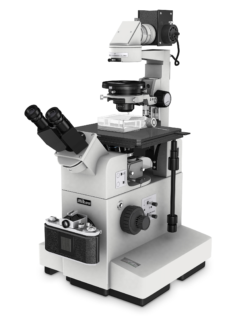Nikon’s Museum of Microscopy
Diaphot TMD Inverted Microscope
( Circa 1980 )

The Diaphot TMD was introduced in 1980 as a technological update to the now classic inverted Bioscience microscope, the Diaphot MD. The Diaphot MD was a long running staple in bio research laboratories all over the world since 1964. With the advent of new technologies such as Chromatic Aberration corrected optics, photomicrography and CCTV technologies, the demands for microscopes that could integrate and support these systems had become imperative.
The TMD had significant improvements including a lower center of gravity stand developed to improve stability, as well as a new V shaped optical path which helped maximize the efficiency of light for low light photomicrographic applications.
Further advances to light efficiency in this system included a low power focusing magnifier for easier focusing in low light, and a built-in dark slide to reroute the light path to either the eye piece or the camera ports with minimal light loss. It also boasted 3 new stage choices which were specifically designed for system flexibility. These new stages allowed for the most basic of microscopy up to Automatic microtest plate scanning and fully automatic scanning.
It was also the first system to be fully designed to accommodate the state-of-the-art Chromatic Aberration corrected CF optics, a significant advance in optical technology.
Because this microscope was also designed to accommodate incubator housings and micromanipulators, this microscope quickly became a popular choice for a relatively new Invitro Fertilization, (IVF) technique. In fact, the Nikon Diaphot TMD was used for the first successful IVF baby in the United States in 1981 and quickly became a mainstay product for this process.













